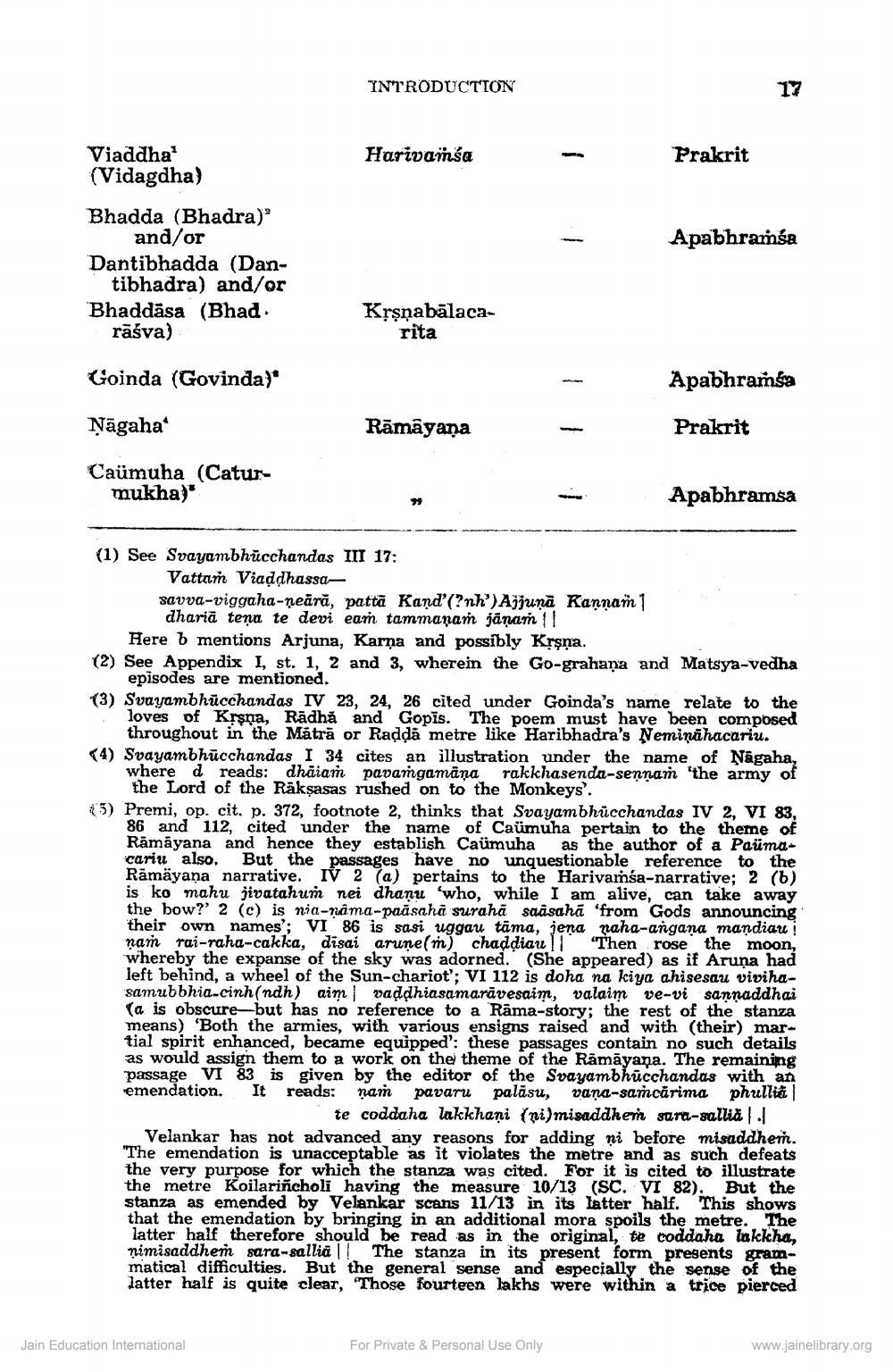________________
INTRODUCTION
17
Harivaisa
Viaddha (Vidagdha)
-
Prakrit
Apabhramsa
Bhadda (Bhadra)"
and/or Dantibhadda (Dan
tibhadra) and/or Bhaddāsa (Bhad.
rāśva)
Kșşņabālaca
rita
Goinda (Govinda)
Apabhramsa
Nāgaha*
Rāmāyana
Prakrit
Caümuha (Catur
mukha)"
Apabhramsa
(1) See Svayambhūcchandas III 17:
Vattañ Viaddhassa savva-viggaha-neārā, patta Kand'?nh') Ajjuna Kannañ 1
dharia tena te devi eam tammanań jäņam 11 Here b mentions Arjuna, Karna and possibly Krşņa. (2) See Appendix I, st. 1, 2 and 3, wherein the Go-grahaņa and Matsya-vedha
episodes are mentioned. (3) Svayambhücchandas IV 23, 24, 26 cited under Goinda's name relate to the
loves of Krsna, Rädhă and Gopis. The poem must have been composed
throughout in the Matrā or Raddă metre like Haribhadra's Neminahacariu. (4) Svayambhūcchandas I 34 cites an illustration under the name of Nāgaha,
where d reads: dhaiam pavargamāņa rakkhasenda-sennam 'the army of
the Lord of the Räkşasas rushed on to the Monkeys'. 5) Premi, op. cit. p. 372, footnote 2, thinks that Svayambhucchandas IV 2, VI 83,
86 and 112, cited under the name of Caümuha pertain to the theme of Ramayana and hence they establish Caümuha as the author of a Paümdcariu also. But the passages have no unquestionable reference to the Ramayana narrative. IV 2 (a) pertains to the Harivamśa-narrative; 2 (b) is ko mahu jivatahum nei dhanu 'who, while I am alive, can take away the bow?' 2 (c) is nia-nama-paāsaha suraha saasahā 'from Gods announcing their own names'; VI 86 is sasi uggau tāma, jena raha-angana mandian nań rai-raha-cakka, disai arunelm) chaddiau ll "Then rose the moon, whereby the expanse of the sky was adorned. (She appeared) as if Aruna had left behind, a wheel of the Sun-chariot'; VI 112 is doha na kiya ahisesau vivihasamubbhia-cinh(ndh) aim vaddhiasamarāvesaim, valaim ve-vi sannaddhai (a is obscure-but has no reference to a Rāma-story: the rest of the stanza means) 'Both the armies, with various ensigns raised and with (their) martial spirit enhanced, became equipped': these passages contain no such details as would assign them to a work on the theme of the Rāmāyana. The remaining passage VI 83 is given by the editor of the Svayambhūcchandas with an emendation. It reads: nam pavaru palāsu, vana-sarcărima phullia
te coddaha lakkhani (ri)misaddher sara-sallia. Velankar has not advanced any reasons for adding ni before misaddheň. "The emendation is unacceptable as it violates the metre and as such defeats the very purpose for which the stanza was cited. For it is cited to illustrate the metre Koilariñcholi having the measure 10/13 (SC. VI 82). But the stanza as emended by Velankar scans 11/13 in its latter half. This shows that the emendation by bringing in an additional mora spoils the metre. The latter half therefore should be read as in the original, te coddaha lakkha, nimisaddhem sara-sallia || The stanza in its present form presents grammatical difficulties. But the general sense and especially the sense of the latter half is quite clear, "Those fourteen lakhs were within a trice pierced
Jain Education International
For Private & Personal Use Only
www.jainelibrary.org




